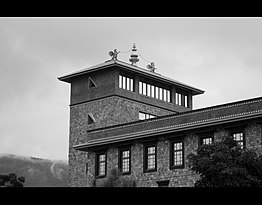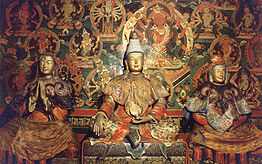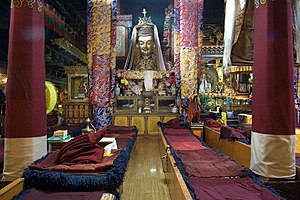迷失畫廊
逛畫廊,看世界, 記下自己的心得Songtsen Gampo
| Songtsen Gampo | |||||
|---|---|---|---|---|---|
| Emperor of Tibet | |||||
 | |||||
| Predecessor | Namri Songtsen | ||||
| Successor | Mangsong Mangtsen | ||||
| Born | Songtsen between 557 and 617 Maizhokunggar, Tibet | ||||
| Died | 649 Zal-mo-sgang, 'phun-yul, Tibet (in modern Lhünzhub County) | ||||
| Burial | 651 smu-ri-smug-bo, Valley of the Kings, phying ba'ai | ||||
| Spouse | Pogong Mongza Tricham Bal-mo-bza' Khri-btsun (akaBhrikuti, from Nepal) Gyasa Mung-chang (akaPrincess Wencheng, from Tang China) Mi-nyag-bza' Zhyal-mo-btsun (from Tangut) Ri-thig-man (from Zhangzhung) | ||||
| Issue | Gungsong Gungtsen | ||||
| |||||
| Tibetan | |||||
| Wylie transliteration | Srong-btsan sGam-po | ||||
| THL | Songtsen Gampo | ||||
| Great Minister | [show] list | ||||
| Father | Namri Songtsen | ||||
| Mother | Driza Tökarma | ||||
| Religion | Tibetan Buddhism | ||||
| Part of a series on |
| Tibetan Buddhism |
|---|
 |
Songtsen Gampo[1] (Tibetan: ???????????????, Wylie: srong btsan sgam po, 569–649?/605–649?) was the 33rd Tibetan king and founder of the Tibetan Empire[a], and is traditionally credited with the introduction of Buddhism to Tibet, influenced by his Nepali and Chinese queens, as well as being the unifier of what were previously several Tibetan kingdoms.[2] He is also regarded as responsible for the creation of the Tibetan alphabet and therefore the establishment of Classical Tibetan, the language spoken in his region at the time, as the literary language of Tibet.
His mother, the queen, is identified as Driza Tökarma (Wylie: 'bri bza thod dkar ma "the Bri Wife [named] White Skull Woman"). The dates of his birth and when he took the throne are not certain. In Tibetan accounts, it is generally accepted that he was born in an Ox year of the Tibetan calendar, which means one of the following dates: 557, 569, 581, 593, 605 or 617 CE.[3] He is thought to have ascended the throne at age thirteen (twelve by Western reckoning), by this reckoning c. 629.[2][4]
There are difficulties with this position, however, and several earlier dates for the birth of Songtsen Gampo have been suggested, including 569, 593 or 605.[5]
鬆讚幹布(藏文:????????????????;藏語拚音:Songzän Gambo;威利:Srong bTsan sGam Po;THL:Songtsen Gampo;[1]-650年),是吐蕃雅魯王朝第33任讚普,也是吐蕃帝國的建立者,約629年至650年在位。他是前任讚普囊日論讚的兒子。
原名赤鬆讚(藏文:?????????????;藏語拚音:Chisongzän;威利:Khri Srong bTsan),[5]“鬆讚幹布”是其尊號,意思是“心胸深邃的鬆讚”。[6]《新唐書》作棄宗弄讚、棄蘇農,《冊府元龜》作器宗弄讚、器宋弄讚、不弗弄讚,《通典》作棄蘇農讚。[7]在位期間,他大大擴張了吐蕃的版圖,定都拉薩,並確立了吐蕃的政治、軍事、經濟及法律等製度,為日後吐蕃成為強盛大國打下基礎。他通過與泥婆羅(今尼泊爾)的聯姻,提高了吐蕃的工藝技術水平;通過與唐朝的和親,從唐朝引入先進的科學、醫學和曆法,提高了吐蕃人的文化水平。[8]據傳佛教也是通過兩次聯姻首次進入西藏。拉薩的布達拉宮也是其在位期間建立的。
貞觀十四年(640年),鬆讚幹布派遣祿東讚出使唐朝求婚,迎娶文成公主。鬆讚幹布在邏些西北海拔3700公尺的紅山上興建布達拉宮,以迎公主。
貞觀十五年(641年),江夏郡王、禮部尚書李道宗護送文成公主入吐蕃,以釋迦牟尼像、珍寶、經書、經典360卷等作為嫁妝。鬆贊幹布從邏些(今西藏拉薩)趕到柏海(今青海鄂陵湖或劄陵湖)迎接。唐封他為“駙馬都尉、西海郡王”。唐高宗繼位以後,又封之為賨王。鬆贊幹布從唐朝學習天文、曆法等科學,創製藏曆;又遣貴族子弟至長安學習詩書,以提高吐蕃人的知識水平。[14]
文成公主入藏是大唐與吐蕃統治者之間第一次建立起正式的聯繫。在此之後,吐蕃與唐成為盟國,和平共處,沒有發生戰爭,但在鬆讚幹布逝世後數年戰端重起。
Contents
[hide]
Early life and cultural background[edit]
It is said that Songtsen Gampo was born at Gyama in Meldro, a region to the northeast of modern Lhasa), the son of the Yarlung king Namri Songtsen. The book The Holder of the White Lotus says that it is believed that he was a manifestation of Avalokite?vara, of whom the Dalai Lamas are similarly believed to be a manifestation.[6] His identification as a cakravartin and incarnation of Avalokite?vara began in earnest in the indigenous Buddhist literary histories of the 11th century.[7]
Family[edit]
Some Dunhuang documents say that, as well as his sister Sad-mar-kar (or Sa-tha-ma-kar), Songtsen Gampo had a younger brother who was betrayed and died in a fire, sometime after 641. Apparently, according to one partially damaged scroll from Dunhuang, there was hostility between Sa-tha-ma-kar and Songtsen Gampo's younger brother, bTzan-srong, who, as a result, was forced to settle in gNyal (an old district to the southeast of Yarlung and across the 5,090 metres (16,700 ft) Yartö Tra Pass, which bordered on modern Bhutan and Arunachal Pradesh in India). Little, if anything, else is known about this brother.[8][9]
Songtsen Gampo's mother, the queen, is identified as a member of the Tsépong clan Wylie: tshe spong, Tibetan Annals Wylie: tshes pong), which played an important part in the unification of Tibet. Her name is recorded variously but is identified as Driza Tökarma ("the Bri Wife [named] White Skull Woman", Wylie: 'bri bza' thod dkar ma, Tibetan Annals Wylie: 'bring ma tog dgos).[10]
Songtsen Gampo had six consorts, of whom four are considered "native" and two - the well-known ones - foreign.[11] Highest-ranking was Pogong Mongza Tricham (Wylie: pho gong mong bza' khri lcam, also called Mongza, "the Mong clan wife", who is said to have been the mother of Gungsong Gungtsen.[12] Other notable wives include a noble woman of the Western Xia known as Minyakza("Western Xia wife", Wylie: mi nyag bza'),[13] and a noble woman from Zhangzhung. Well-known even today are his two 'foreign' wives: the Nepali princess Bhrikuti ("the great lady, the Nepalese wife", Wylie: bal mo bza' khri btsun ma) as well as the Chinese Princess Wencheng ("Chinese Wife", Wylie: rgya mo bza').[11] These two wives are credited in Tibetan tradition in playing crucial roles in the adoption of Buddhism in Tibet and held to explain the two great influences on Tibetan Buddhism, Indo-Nepali and Chinese.
Songtsen Gampo's heir, Gungsong Gungtsen, died before his father, so his son, Mangsong Mangtsen, took the throne. His mother is sometimes said to have been a Chinese princess (Wylie: kong jo) but this is thought to be highly unlikely. His mother was most probably Mangmoje Trikar (Wylie: mang mo rje khri skar),[14] who is mentioned in the Genealogy found in the hidden library in the caves in Dunhuang, the Tibetan Annals, which list the names of the Tibetan emperors and the names of their consorts who bore future emperors, and the clans they came from).[15]
Some accounts say that when Gungsong Gungtsen reached the age of thirteen (twelve by Western reckoning), his father, Songtsen Gampo, retired, and he ruled for five years (which could have been the period when Songtsen Gampo was working on the new constitution). Gungsong Gungtsen is also said to have married 'A-zha Mang-mo-rje when he was thirteen, and they had a son, Mangsong Mangtsen (r. 650-676 CE). Gungsong Gungtsen is said to have only ruled for five years when he died at eighteen. His father, Songtsen Gampo, took the throne again.[16] Gungsong Gungtsen is said to have been buried at Donkhorda, the site of the royal tombs, to the left of the tomb of his grandfather Namri Songtsen (gNam-ri Srong-btsan). The dates for these events are very unclear.[17][18][19] According to Tibetan tradition, Songtsen Gampo was enthroned while still a minor as the thirty-third king of the Yarlung Dynasty after his father was poisoned circa 618.[20][21] He is said to have been born in an unspecified Ox year and was 13 years old (12 by Western reckoning) when he took the throne. This accords with the tradition that the Yarlung kings took the throne when they were 13, and supposedly old enough to ride a horse and rule the kingdom.[22] If these traditions are correct, he was probably born in the Ox year 605 CE. The Old Book of Tang notes that he "was still a minor when he succeeded to the throne."[20][23]
The current head of the Royal House of Tibet and king in exile is a direct descendant of the Dharma kings [24] and crowned King of Tibet by Tenzin Gyatso, 14th Dalai Lama [25] is His Majesty King Lhagyari Trichen Namgyal Wangchuk[26] The King lives in the United States and travels the world speaking out for the human and religious rights of the Tibetan people, under the occupation of the People's Republic of China.[27]
Cultural activities[edit]
Songtsen Gampo is said to have sent his minister Thonmi Sambhota to India to devise a script for Classical Tibetan, which led to the creation of the first Tibetan literary works and translations, court records and a constitution.[28] After Thonmi Sambhota returned from India, Songtsen Gampo stayed in a cave for three years with Thonmi Sambhota to learn whatever he had learned in India.
Songtsen Gampo moved the seat of his newly unified kingdom from the Yarlung Valleyto the Kyichu Valley, site of the future city of Lhasa. The site itself was originally a herding ground called Rasa ("the place of goats") but the name was changed to Lhasa ("the place of gods") on the king's founding of the Jokhang Temple.[29] The name Lhasa itself originally referred simply to the temple precincts.
He is also credited with bringing many new cultural and technological advances to Tibet. The Jiu Tangshu, or Old Book of Tang, states that after the defeat in 648 of an Indian army in support of Chinese envoys, the Chinese Emperor, Gaozong, a devout Buddhist, gave him the title variously written Binwang, "Guest King" or Zongwang, "Cloth-tribute King" and 3,000 rolls of multicoloured silk in 649[30]and granted the Tibetan king's request for "silkworms' eggs, mortars and presses for making wine, and workmen to manufacture paper and ink."[31]
Traditional accounts say that, during the reign of Songtsen Gampo, examples of handicrafts and astrological systems were imported from China and the Western Xia; the dharmaand the art of writing came from India; material wealth and treasures from the Nepalis and the lands of the Mongols, while model laws and administration were imported from the Uyghurs of the Turkic Khaganate to the North.[32]
Introduction of Buddhism[edit]
Songtsen Gampo is traditionally credited with being the first to bring Buddhism to the Tibetan people. He is also said to have built many Buddhist temples, including the Jokhang in Lhasa, the city in which he is credited in one tradition with founding and establishing as his capital,[33][34] and Tradruk Temple in Nêdong. During his reign, the translation of Buddhist texts from Sanskrit into Tibetan began.[35]
Songtsen Gampo is considered to be the first of the three Dharma Kings (Wylie: chos rgyal) — Songtsen Gampo, Trisong Detsen, and Ralpacan — who established Buddhism in Tibet.
The inscription on the Skar cung Pillar (erected by Ralpacan, who ruled c. 800-815) reports that during Songtsen Gampo's reign, "shrines of the Three Jewels were established by building the temple of Ra-sa [Lhasa] and so on."[36] The first edict of Trisong Detsen mentions a community of monks at this vihara.[37]
620s[edit]
Songtsen Gampo was adept at diplomacy as well as on the field of battle. The king's minister, Nyang Mangpoje Shangnang, with the aid of troops from Zhangzhung, defeated the Sumpa in northeastern Tibet circa 627 (Tibetan Annals [OTA] l. 2).
630s[edit]
Six years later (c. 632/633), Myang Mang-po-rje Zhang-shang was accused of treason and executed (OTA l. 4-5, Richardson 1965). Minister Mgar-srong-rtsan succeeded him.
The Jiu Tangshu records that the first ever embassy from Tibet arrived in China from Songtsen Gampo in the 8th Zhenguan year, or 634 CE.[38] Tang dynasty chronicles describe this as a tribute mission, but it brought an ultimatum demanding a marriage alliance, not subservient rituals. After this demand was refused, Tibet launched victorious military attacks against Tang affiliates in 637 and 638.[39]
The conquest of Zhang Zhung[edit]
There is some confusion as to whether Central Tibet conquered Zhangzhung during the reign of Songtsen Gampo or in the reign of Trisong Detsen (r. 755 until 797 or 804 CE).[40] The Old Book of Tang do seems to place these events clearly in the reign of Songtsen Gampo, for they say that in 634, Yangtong (Zhangzhung) and various Qiang peoples "altogether submitted to him." Following this, he united with the country of Yangtong to defeat the 'Azha, or Tuyuhun, and then conquered two more tribes of Qiang before threatening Songzhou with an army of (according to the Chinese) more than 200,000 men (100,000 according to Tibetan sources).[41] He then sent an envoy with gifts of gold and silk to the Chinese emperor to ask for a Chinese princess in marriage and, when refused, attacked Songzhou. According to the Tang annals, he finally retreated and apologised, and, later, the emperor granted his request,[42][43] but the histories written in Tibet all say that the Tibetan army defeated the Chinese and that the Tang emperor delivered a bride under threat of force.[41]
Early Tibetan accounts say that the Tibetan king and the king of Zhangzhung had married each other's sisters in a political alliance. However, the Tibetan wife of the king of the Zhangzhung complained of poor treatment by the king's principal wife. War ensued, and, through the treachery of the Tibetan princess, "King Ligmikya of Zhangzhung, while on his way to Sum-ba (Amdoprovince) was ambushed and killed by King Srongtsen Gampo's soldiers. As a consequence, The Zhangzhung kingdom was annexed to Bod [Central Tibet]. Thereafter the new kingdom born of the unification of Zhangzhung and Bod was known as Bod rGyal-khab."[44][45][46] R. A. Stein places the conquest of Zhangzhung in 645.[47]
Further campaigns[edit]
He next attacked and defeated the Tangut people who later formed the Western Xia state in 942 CE), the Bailang, and Qiang tribes.[48][49] The Bailan people were bounded on the east by the Tanguts and on the west by the Domi. They had been subject to the Chinese since 624.[50]
After a successful campaign against China in the frontier province of Songzhou in 635–36 (OTA l. 607),[51] the Chinese emperor agreed to send a Chinese princess for Songtsen Gampo to marry.
Around 639, after Songtsen Gampo had a dispute with his younger brother Tsensong (Wylie: brtsan srong), the younger brother was burnt to death by his own minister, Khasek (Wylie: mkha' sregs), possibly at the behest of the emperor.[52][53]
640s[edit]
The Old Book of Tang records that when the king of 泥婆羅, Nipoluo ("Nepal"),[54] the father of Licchavi king Naling Deva (or Narendradeva), died, an uncle, Yu.sna kug.ti, Vishnagupta) usurped the throne.[55] "The Tibetans gave him refuge and reestablished him on his throne [in 641]; that is how he became subject to Tibet."[23][56][57]
Sometime later, but still within the Zhenguan period (627-650 CE), the Tibetans sent an envoy to present day Nepal, where the king received him "joyfully", and, later, when a Tibetan mission was attacked in present-day India by then minister of emperor Harshavardhan who had usurped the throne after emperor Harshavardhan's death around 647 AD,[58] the Licchavi king came to their aid.[59] Songtsen Gampo married Princess Bhrikuti, the daughter of King Licchavi.
The Chinese Princess Wencheng, niece of the Emperor Taizong of Tang, left China in 640 to marry Songtsen Gampo, arriving the next year. Peace between China and Tibet prevailed for the remainder of Songtsen Gampo's reign.
Both wives are considered to have been incarnations of Tara (Standard Tibetan: Drolma), the Goddess of Compassion, the female aspect of Chenrezig:
- "Dolma, or Drolma (Sanskrit Tara). The two wives of Emperor Srong-btsan gambo are venerated under this name. The Chinese princess is called Dol-kar, of 'the white Dolma,' and the Nepalese princess Dol-jang, or 'the green Dolma.' The latter is prayed to by women for fecundity."[60]
The Jiu Tangshu adds that Songtsen Gampo thereupon built a city for the Chinese princess, and a palace for her within its walls.
- "As the princess disliked their custom of painting their faces red, Lungstan (Songtsen Gampo) ordered his people to put a stop to the practice, and it was no longer done. He also discarded his felt and skins, put on brocade and silk, and gradually copied Chinese civilization. He also sent the children of his chiefs and rich men to request admittance into the national school to be taught the classics, and invited learned scholars from China to compose his official reports to the emperor."[61]
However, according to Tibetologist John Powers, such accounts of Tibet embracing Chinese culture through Wencheng are not corroborated by Tibetan histories.[62]
Songtsen Gampo's sister Sad-mar-kar was sent to marry Lig-myi-rhya, the king of Zhangzhung. However, when the king refused to consummate the marriage, she then helped Songtsen Gampo to defeat Lig myi-rhya and incorporate the Zhangzhung of Western Tibet into the Tibetan Empire in 645,[58] thus gaining control of most, if not all, of the Tibetan plateau.
Following the visit by the famous Chinese pilgrim monk Xuanzang to the court of Harsha, the king ruling Magadha, Harsha sent a mission to China which, in turn, responded by sending an embassy consisting of Li Yibiao and Wang Xuance, who probably travelled through Tibet and whose journey is commemorated in inscriptions at Rajagrha - modern Rajgir – and Bodhgaya.
Wang Xuanze made a second journey in 648, but he was badly treated by Harsha's usurper, his minister Arjuna, and Harsha's mission plundered. This elicited a response from Tibetan and Nepalese (Licchavi) troops who, together, soundly defeated Arjuna's forces.[63][64]
In 649, the King of Xihai Jun was conferred upon Songtsen Gampo by Tang Gaozong, the emperor of the Tang Dynasty.
According to the Tibetan Annals, Songtsen Gampo must have died in 649,[65] and, in 650, the Tang emperor sent an envoy with a "letter of mourning and condolences".[66] His tomb is in the Chongyas Valley near Yalung.[67]













